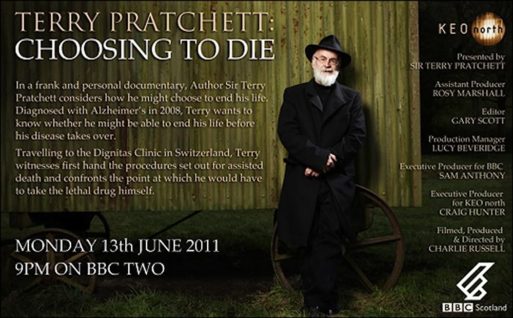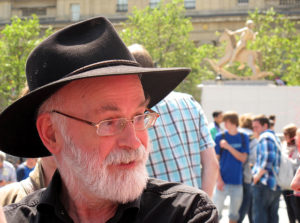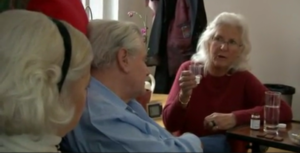 When author Terry Pratchett was diagnosed with Alzheimer’s disease, he had to confront an uncomfortable decision: Should he see his illness through to the end (and risk losing his dignity in the process), or should he choose to end his life prematurely? To find answers, he teamed up with director Charlie Russell to create the television documentary “Terry Pratchett: Choosing to Die.”
When author Terry Pratchett was diagnosed with Alzheimer’s disease, he had to confront an uncomfortable decision: Should he see his illness through to the end (and risk losing his dignity in the process), or should he choose to end his life prematurely? To find answers, he teamed up with director Charlie Russell to create the television documentary “Terry Pratchett: Choosing to Die.”
In the film, which aired on the BBC, Pratchett and Russell follow two men from the United Kingdom who have decided to end their lives in response to serious medical illnesses. At the time the documentary was made, aid in dying was illegal in the UK. People who wished to end their own lives had to travel to Switzerland, where aid in dying is legal. Throughout the film, we see Pratchett and his assistant, Rob Wilkins, travel to Switzerland alongside their interview subjects, watching them go through the difficult process from start to finish.
What follows is a heartfelt television documentary that doesn’t sugar coat any of the issues. When the film first aired, the BBC received over 750 complaints from pro-life organizations who viewed aid in dying as morally wrong. However, Pratchett and Russell took a balanced view of the aid-in-dying movement. Although Pratchett eventually decided that people should have the right to end their own lives, this realization came after weeks of research and speaking with patients and their families.
What impressed me most about “Terry Pratchett: Choosing to Die” is that Pratchett wasn’t afraid to ask difficult questions of his subjects, even at their most vulnerable. One man, Andrew Colgan, was just 42 years old when he decided to end his own life. He had been suffering from multiple sclerosis, and he wanted to die while he was still healthy enough to enjoy life, long before his illness could disrupt it.

Terry Pratchett
(Credit: Wikimedia.org)
Although his reasons for dying were clear, Pratchett and his assistant still pressed Colgan for deeper answers. Was this fair to Colgan’s family? Should he wait until the disease progresses further before he ends his life? They were both skeptical, at first, about whether Colgan was making the right choice.
In the end, a moving speech from Colgan’s mother changes both of their minds. She says she doesn’t want Colgan to end his life, however she knows that ultimately it is his choice and that it would be selfish of her to take that choice away from him.
“Terry Pratchett: Choosing to Die” puts this idea of choice at the center of the discussion. One of the most powerful moments in the film is when Pratchett considers his own fate. People who have Alzheimer’s disease typically can’t choose to end their own lives, even in countries where aid in dying is legal. That’s because the disease robs them of their ability to make coherent decisions as the disease progresses.
Every aid-in-dying facility in Switzerland puts patients through a long application process before they administer life-ending drugs. One part of the process involves the patient seeing a doctor twice for a psychological and physical examination. In the film, Pratchett asks one of these doctors whether she would approve an Alzheimer’s patient whose mind was starting to fail. She says that she would not. All patients have to be of sound mind before getting approval.
This moment puts Pratchett in an unusual position. He realizes that if he wants to apply for the aid in dying, he would need to do so soon, long before he felt his symptoms worsen. If he waited too long, he would no longer be eligible.
Ultimately, Pratchett chose a natural death. On March 12, 2015, he died at home, surrounded by his family.

Credit: BBC
Although Pratchett did not choose aid in dying for himself, he became an outspoken advocate for the aid-in-dying movement as he approached the end of his life. What makes his documentary so compelling is that he faced the fears surrounding the movement head-on. He acknowledged that death is a terrifying subject, and that the idea of choosing to die can be a horrifying concept for most people.
Yet he abates those fears by speaking to the real people who make these difficult choices for themselves. Pratchett lifted the veil on the aid-in-dying industry, showing us exactly what one of these deaths looks like; The death of one of his interview subjects was the first assisted death ever shown on terrestrial television.
With more documentaries like “Terry Pratchett: Choosing to Die,” the mystery around aid in dying could slowly disappear, opening up more discussions and allowing more patients to make the choice that’s right for them.

 “Terry Pratchett: Choosing to Die” by BBC
“Terry Pratchett: Choosing to Die” by BBC


 “As Tears Go By” by Marianne Faithfull
“As Tears Go By” by Marianne Faithfull

 Funeral Favors Offer Visitors a Tangible Memento
Funeral Favors Offer Visitors a Tangible Memento















